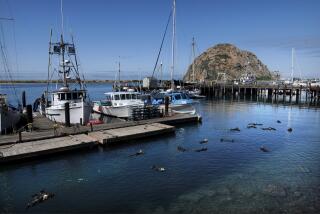Shoring Up Beach Defenses
- Share via
The arrival of 2002 this past week found Orange County residents strolling the beach in casual attire--unthinkable at this time of year in many other climes. A shimmering ribbon of sunlight stretched across a steel-gray band of calm Pacific horizon during the early afternoon, reminding beachgoers of the ever-changing portrait offered by the ocean.
A new year is a time for reflection, and there has been a lot to think about in the 12 years since the Orange County coastline got a wakeup call when hundreds of thousands of gallons of crude oil spilled from a tanker off Huntington Beach. By the summer of 1990, life on Orange County beaches returned to normal, but it was also clear that things would never be quite the same. A big environmental event had shaken the public to a new consciousness of the fragility of the local shoreline and the possibility that precious resources could be damaged. But with the passage of time, it has been the relentless tide of smaller environmental mishaps and threats from inland, rather than any single huge offshore disaster, that has posed the most serious long-term threat to the health of the waterfront.
The tanker accident is still tangled in litigation between plaintiffs who are concerned that their businesses were seriously damaged in 1990 and the defense team for the ship, the American Trader. While that has gone on, the rest of us have experienced more than a decade of threats from urban runoff, sewage spills, beach closings and concern about the discharge into the ocean of partially treated waste.
For much of the last decade, the entire romantic vision of the Orange County shoreline heralded in the Beach Boys’ “Surfin’ USA,” with its catalog of great local beach locations, has been under assault from a procession of bad news about the health of our coastal waters.
At the end of 2001, even as litigants in the oil spill were at an impasse over their damages in a protracted paper war, county officials were giving a bleak accounting of the record of beach closing and harbor pollution incidents. In the last year, sewer spills fouled the county’s beaches and harbors 51 times, an increase of more than 25% over the previous year.
While such spills are small compared with the American Trader accident, they do paint a portrait of a troubled coastline.
The good news is that the public’s consciousness has been raised over this time, and regulatory authorities have displayed a new vigor in enforcing pollution laws. The Santa Ana Regional Water Quality Control Board recently held a public workshop on new regulations that will cover 32 agencies that collect sewage. They forbid all spills that reach waterways and urge better monitoring and cleanup, with fines of $5,000 per day. The increase in reports is also due to better vigilance on the part of local authorities after a recent state law that ordered that beaches be closed if affected by untreated waste. Seal Beach, for example, had parts of its shoreline closed three times last year because of sewage spills in inland cities. A quarter-mile of the city’s beach was closed during the prime season in July by an 8,200 gallon spill in Anaheim. Coastal cities pay a high price in lost business when spills occur upstream.
What is disturbing is that in recent years, such closings have steadily increased. There were seven in 1993, 17 in 1994, 22 each in 1995 and 1996, then the number has continued upward. It is possible to attribute some to better reporting, but inland development and population growth have taken a toll.
Too often the problems come from carelessness about the discharge of materials such as grease that can clog sewer lines.
That’s why the increased monitoring and enforcement are necessary and important. The new rules will have stepped-up monitoring, and agencies must create plans for managing sewer systems, controlling grease and dealing with emergencies. Local agencies and municipalities are going to have to prepare their communities to deal with the inevitability of new expenditures to fix problems.
But it’s also up to all of us to think about the little things we do that create problems for the ocean. Since the American Trader accident in 1990, the threat from within has proved to be greater than the threat from without. The ocean is our friend. We must take care of it.


